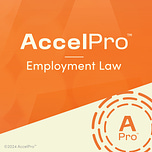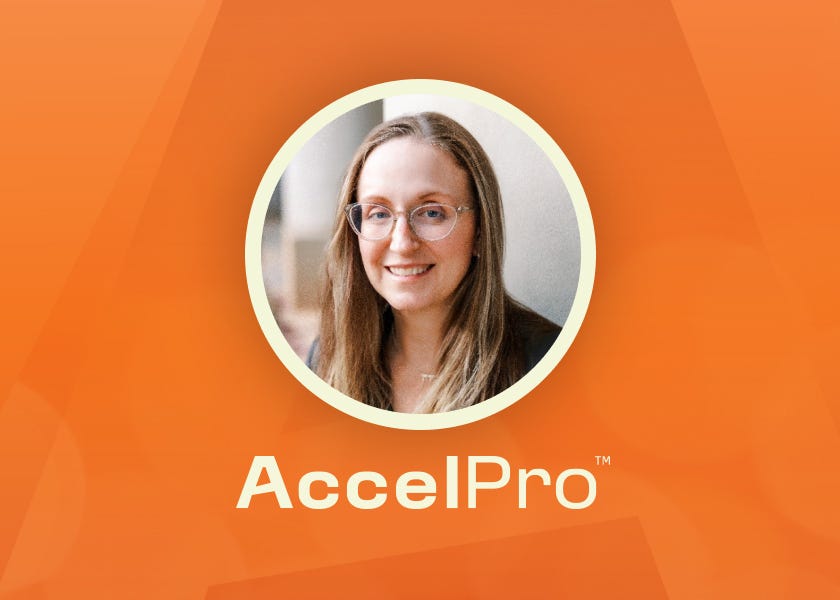AccelPro is built for motivated professionals and innovative companies. Sign up now, and your annual membership will include a free trial and a discount of more than 40%.
Welcome to AccelPro Employment Law, where we provide expert interviews and coaching to accelerate your professional development. Today we are featuring a discussion with Bonnie Levine, Partner at gunnercooke, about ways attorneys can help craft diversity, equity and inclusion (DEI) initiatives that are both legally informed and effective.
“The baseline is that lawyers don’t have a lot of background in diversity, equity and inclusion. And not only that, but because so much of DEI involves a person’s lived experiences, people will tokenize someone based on their lived experience and conflate that with acquired knowledge. The easiest example is, this person is a woman, so they know all about structural gender discrimination,” she says.
“And that’s simply not accurate. I have a diagram I use in some of my presentations that has to do with lived experiences and acquired knowledge. There’s an overlap, but these are two separate categories of knowledge. And one reason why DEI gets so stuck in this legal paradigm is that lawyers don’t understand the expertise that the DEI practitioners have.”
Today’s sample is below. To listen to or read the full AccelPro Employment Law interview, join our paid membership program.
Most AccelPro members expense their memberships or take a tax deduction. Please let us know if your employer has any questions about our community.
Basic Membership: One full interview each month, along with samples of the weekly podcast and occasional events.
Monthly or Annual Membership:
The weekly podcast, available in the player of your choice
Transcripts and supplemental materials for each interview
Private group events inspired by industry trends and your requests
Curated collections from the archive, including Worker Classification and Discrimination
CLE credit based on the interviews is coming soon
If you sign up now, your annual membership will include a free trial and a discount of more than 40%.
Interview References:
Bonnie Levine’s gunnercooke profile.
2:09 | Chang, Edward and Levine, Bonnie. To Drive Efforts...Don't Tiptoe Around Your Legal Risk. (July–August 2022). Harvard Business Review.
5:17 | American Alliance for Equal Rights v. Fearless Fund Management, LLC et al, No. 23-13138. (2023). United States Court of Appeals for the Eleventh Circuit.
11:44 | Standards and Rules of Procedure for Approval of Law Schools, 303(c). (2023-2024). American Bar Association Section of Legal Education and Admissions to the Bar.
TRANSCRIPT
Matt Crossman, Host: You co-wrote an article for Harvard Business Review with the headline, “To Drive Diversity Efforts, Don’t Tiptoe Around Your Legal Risk,” in which you make the case that the DEI team and the legal team don’t have to always be at odds.
You offer suggestions about how they can fruitfully work together. Before we get to that, I want to set the table about your background. You studied behavioral sciences. How does that inform how you advise companies?
Bonnie Levine: So I think that behavior science, behavior economics and basically psychological disciplines are incredibly relevant in the practice of law generally, but particularly in the law involving the workplace and the law involving workplace identities. We are really becoming more conscious of the way personal identity affects how we show up in the workplace.
And that’s an area in which if you’re giving legal advice that is entirely separate from how humans behave and how humans act, it’s not going to actually be implemented.
MC: Let’s start with the DEI legal landscape and how complicated that has become lately, in large part because of what you just said—because of emerging trends about how identity plays a factor in the workplace. I’m curious about the plaintiffs in these suits that you study. Are these primarily organizational plaintiffs or employees?
BL: So that’s the right and the most interesting question. And what I would say is a lot of the lawsuits are so-called reverse discrimination lawsuits, meaning someone from a historically not oppressed group such as men in a gender setting or white individuals in a racial or ethnicity setting brings a lawsuit under one of the federal anti-discrimination laws that applies in all directions.
So these laws are equality-based, meaning if an organization discriminates against someone based on a characteristic such as race or gender it doesn’t matter which direction that goes. At least on the surface, it doesn’t.
There are a number of organizational plaintiffs, meaning non-profit organizations, whose core focus is making law favorable to the type of policy result that they want. The reason why I said that this is really the right question to be asking is because the organizational plaintiffs have a different purpose in bringing a lawsuit than an individual employee plaintiff.
This litigation isn’t really being driven by individual employees with individual employment concerns that they are organically experiencing in their workplace. It is part of an effort to make case law by strategically suing particular organizations.
One of the cases was brought by an organization called American Alliance for Equal Rights against a defendant called Fearless Fund. Fearless Fund specializes in providing grants for Black-owned businesses specifically. This type of organization that specifically brands itself as for minority-owned businesses is what one would consider a high-risk target for this type of lawsuit, whereas your run-of-the-mill employer who is engaged in DEI efforts does not need to fear this type of lawsuit in the same way.
So that is really the high-level advice that I tend to give to organizations: have some perspective when you hear about this type of lawsuit. There are other legal risks that are in the mix, too, that often don’t get as much news because these organizations’ purpose is to get into the news. Their purpose is to make the law they want. They’re in it for policy. That policy is their goal. So organizations that are centering this type of lawsuit when they make legal-risk decisions surrounding DEI are not really seeing the full picture of legal risk.
MC: That leads right into my next question. So I’m an attorney at a place that you would think is lower risk. What do I need to understand better about the DEI process so I can do my job better?
BL: When you say the DEI process, I find that terminology interesting. I like the word process or journey to refer to what a lot of organizations are on at the moment. They are on a DEI journey. Those words get used a lot—because it is a process or a journey. It can’t be thought of as a destination because it is constantly evolving. We’re constantly learning new things, and there’s no perfection that can be achieved in this DEI effort.
So I guess the first answer to the question is, No. 1, understand that it’s a process. No. 2, go for authenticity rather than performativity, and No. 3, which is related, is to be goal-oriented.
And I want to explain what I mean by that, because this is a big subject in these recent cases.
The reason a lot of organizations are revisiting their DEI initiatives is because there’s some question as to whether setting numerical diversity targets is less legal than it used to be. And so when I say be goal-oriented, I don’t mean numerical goal setting specifically, because that has a very particularized connotation.
But I do think it’s important to be goal-oriented in the sense of ask yourself why. Ask yourself questions about what you’re doing before you do it. That part of goal orientation is incredibly critical to compliant DEI initiatives.
MC: In the course of interviewing lawyers, I’ve heard the same statement across multiple different areas of law. “By the time they called me, it was too late. If they had called me earlier, I could have helped them avoid the problem.”
You address this in a way, in the Harvard piece. This is a quote from you: “When lawyers sense that there is no time or appetite for them to do their jobs properly, they tend to focus on one thing: not committing malpractice.”
You mentioned in your piece that DEI execs will have this whole process where they create this program and at the last minute they send it to the lawyer to approve it. And if they say no, they're stuck. How important is it to get lawyers involved early?
BL: As not to give the stock answer, which is, of course, get lawyers involved as early as possible, I want to answer that question by discussing a little bit of the behavioral angle of why it happens that way. Why don’t people involve lawyers?
Listen to this episode with a 7-day free trial
Subscribe to AccelPro | Employment & Labor Law to listen to this post and get 7 days of free access to the full post archives.












